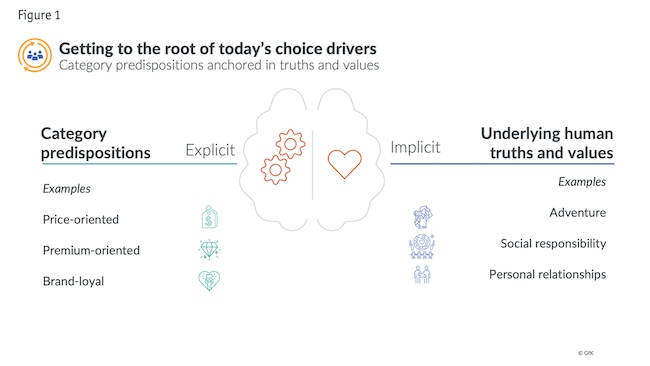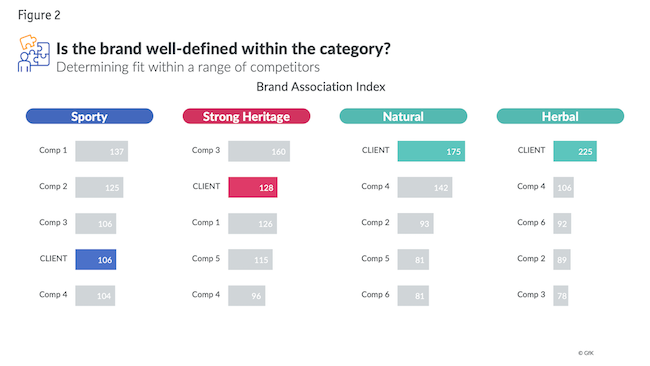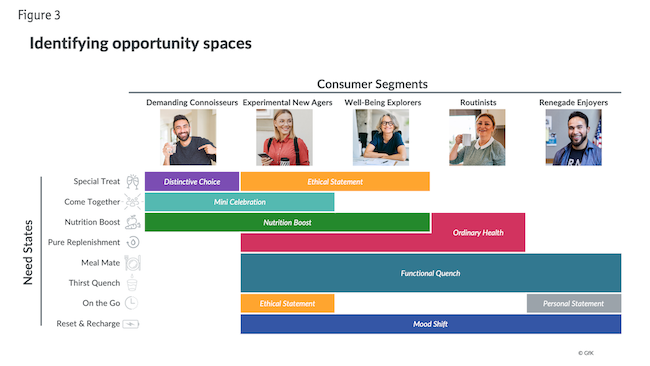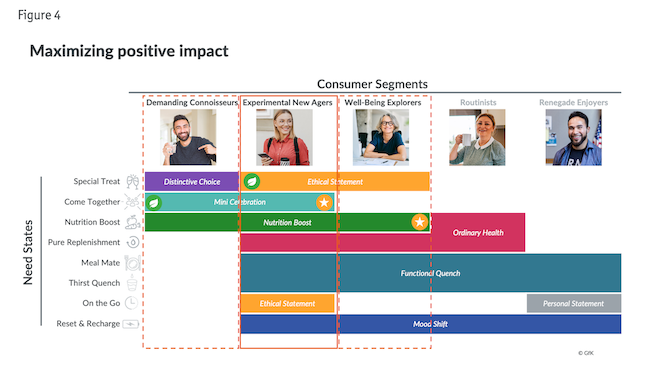Look beyond the low-hanging fruit
Editor's note: Luis Molina is vice president of consumer insights at GfK. He can be reached at luis.molina@gfk.com.
Today, marketers are increasingly segmenting to target small groups of consumers for short-term gains. It makes complete sense. To peel away shoppers from other brands, marketers focus on narrower and narrower slices of the population. As a result, consumers now expect almost every product to be made and marketed “just for them” – from features to packaging to store placement. If SKUs were any more customized, they would be monogrammed with the buyer’s initials.
But for brands, there is a rub with this approach – and it is no small concern.
“Narrowcast” targeting by itself does not build a healthy brand in the long term. Why? Because you need to develop a rich funnel of future buyers before you start drilling down and matching specific targets to compatible brands.
In fact, the key to building long-term success is to achieve greater mental availability for your brand across a wider array of occasions and people. Marketers must integrate KPIs such as brand performance into their segmentation methodologies to assess how well a brand fits against key segment and occasion needs. We can then use these to determine not only among whom and when the brand has the best “right to play” but also identify opportunities where it can penetrate the consideration set further.
In the words of Mark Ritson – a leading thinker in marketing and brand management – “The only way to achieve sustainable … growth is to balance targeted activation with brand-building aimed at the whole market – it’s not either-or.”1
Activating this kind of two-pronged approach to segmentation – merging short- and long-term focuses – requires innovative thinking and a continuous program of data assessment and refreshing. Anything less will create a costly imbalance and lead to challenges that no brand wants to deal with.
A world turned upside down
The dangers of doing traditional segmentation and targeting poorly are right in front of us at this moment. Retailers of every stripe, from Costco to Target, are currently going through their version of “Stranger Things,” living in a world turned upside down. Despite inflation and double-digit cost increases, retailers are offering deep discounts in an all-out effort to clear the inventory overflowing in their stores and distribution centers.2 These surpluses are decimating retailers’ working capital and share prices, with no end in sight.
In this era of big data and real-time dashboards, how can retailers and brands have misunderstood their customers’ desires in such a big way?
Marketers and researchers have become heavily focused on understanding and targeting people based on near-term information – current purchases, social posts, comments and what’s trending. But these data streams leave out key information and perspectives essential for decision making. And they focus on short-term hits rather than broader, sustained growth. Selling mass quantities of one or two SKUs to narrowly defined consumer groups will not be enough to drive big-name brand success over the course of three, five or 10 years.
The good news is that, when applied correctly, the building blocks of segmentation give us essential learning that we can leverage to take on that bigger brand picture. Done well, we can play both sides of the game, using some of the same information to achieve narrow-targeting wins and longer-term brand acceleration.
So how do we get segmentation right in this age of increasingly complex consumers and almost unlimited brand interactions? First, we need to segment more effectively – and then reach across those groups to find commonalities for broader product and marketing outreach. Here are four essential steps for getting this new approach to segmentation right.
1. Create a holistic understanding of long-term choice drivers by segment
In addition to understanding the traditional ways we segment and target – such as defining consumers based on their category-specific leanings and behaviors (e.g., more price-conscious, more quality-oriented, want advanced features, want basic functionality) – we also need to identify consumers’ general predispositions to brand choices. To begin with, we must zero-in on peoples’ personal values and life principles. From being adventuresome to valuing personal relationships to placing emphasis on things like social responsibility, values implicitly drive brand choices (Figure 1).

According to GfK Consumer Life – which interviews over 30,000 people in 27 different countries annually – over three-fifths of global consumers indicate that they “only buy products and services that appeal to their beliefs or ideals.”3 Moreover, other GfK research shows that consumers are more likely to pay a premium for “a brand that has strong and clear values they identify with.”
What can brands learn from these findings? The brands consumers like and buy are not just driven by how well they deliver on category-specific needs. Increasingly, brands must also consider consumers’ broader sensibilities. A successful segmentation will take these implicit choice drivers into account.
Toyota is an example of brand that has been able to successfully leverage values-based marketing through its “Adventure Awaits” campaign, which shows how its SUVs can help bring more adventurous experiences – either actual or vicarious – to its customers’ lives, thus tapping into an essential value that defines many people.
2. Define the situational factors affecting brand choice in the moment of truth
While people have overarching principles that guide many of their choices, the specific situations in which they find themselves also influence their decisions. For instance, consumers who are typically defined by health-oriented attitudes – eating foods that are nutritious, for example – may still pick options that are more indulgent in certain circumstances. When surrounded by friends, or at a special event, their values may take a back seat, if only for a minute or an hour or a day.
An important lens for viewing how brands and consumers connect (or not) is Jobs to Be Done. It is imperative to understand consumers’ underlying goals (or jobs) when they are shopping or consuming, with most falling into three key categories:
Functional – e.g., healthy, close at hand, inexpensive
Emotional – e.g., nostalgic, relaxing, stimulating
Social – e.g., connecting, celebrating, self-care
In addition to traditional people-oriented segmentations, studies can also identify segments of occasions (often called need states) that operate at the moment of consumption. (Examples from food and beverage are Pick Me Up or Treat Myself.) Understanding how consumer needs may vary according to the situational context is a critical ingredient that helps marketers understand opportunities to increase the mental availability of their brand.
3. Understand how your brand fits in the competitive landscape
To be truly actionable, a segmentation should also assess how a brand compares to its competition against a set of key customer needs. In Figure 2, we have identified four important requirements that our client – a natural remedy – must focus on in order to maximally appeal to important target segments. What we are seeing is that the brand is performing only average on the first (and most important) key need (Sporty); and while it is doing much better on Strong Heritage, our brand still trails the category leader by a significant margin. On the last two attributes, though, the client’s brand is clearly the best-in-class.

In fact, the attributes on which the brand performed so well are key to one specific target segment – which tells us that the client should maintain its positioning as a natural and herbal brand. Secondly, because the first two attributes were really critical to tapping into the most lucrative segments, our analysis gave them a very specific roadmap for penetrating these segments.
Ultimately, the goal is to remind as many consumers as possible that the brand exists and that it can meet the requirements of the moment. By focusing on the top of the marketing funnel in this way, we are giving our brand greater odds of being considered and tried in different moments, and of ultimately generating a stronger base of occasional and even loyal users.
4. Quantify how brands match up with consumers over the long term
Now that we have learned to create more effective segmentations – ones that take into consideration growing consumer complexity as well as the important situational contexts – let’s switch gears and talk about how we can leverage this learning to attain greater growth for our brands over the long term as well.
Segmentations usually accentuate differences but here we will look across the market for similarities and common threads that connect people. The goal: to build a brand that is more widely accepted, resonates and positively impacts people.
The first step is to cross the consumer segments with the situational contexts to identify your brand’s opportunity (or demand) spaces. Examining your brand’s positive or negative impact across both consumer types well as need states helps us both synthesize a lot of information and identify ways to appeal to different consumer segments at the same time.
In Figure 3 we see an example of what this type of intersection looks like based on non-alcoholic beverages. Across the top we have the consumer segments, which are defined on broad category and non-category attitudes and personal values. And along the side we have the beverage need states, which boil down different consumption occasions into focused needs, like having a treat or having a moment of connection with others.

When we cross these two systems together, we can group some of the intersections into common themes. For example, when choosing beverages for a Special Treat, both Experimental New Agers and Well-Being Explorers (Figure 4) tell us that making an ethical statement about what they choose is operative for them in those situations.

This crossing of segments with need states is really wonderful in its own right, in that it helps us to synthesize a lot of information in one view. However, leveraging commonalities across segments or need states that are otherwise distinct also gives us some tactical advantages to help us grow our brand beyond any core target segments or need states that may have been identified from earlier opportunity-sizing. In this case, Experimental New Agers were identified as a priority segment based on value modeling, while Well-Being Explorers were considered secondary. But knowing that Ethical Moments were common to both gave us an entrée to talking to and ultimately appealing to Well-Being Explorers.
Close off your brand
Segmentation – the foundational approach for marketers since the dawn of consumer research – often accentuates differences and can inadvertently close off your brand to many consumers and situations. In this new approach, we explored 1) how to quantify today’s complex consumers through sophisticated segmentation and 2) use segmentation to look across the market for similarities and common threads that connect people. Intersecting consumer mind-sets with situational contexts will identify new opportunities for growth in different ways. It will reveal new potential positioning platforms and commonalities to appeal to a greater range of consumers across more occasions over time.
References
1 “Targeting or mass marketing? The answer is both.” Marketingweek.com, August 2, 2018
2 “Retailers have too much stuff.” Axios.com, June 6, 2022
3 Consumer Life – Consumer Trends & Predictions Study, GfK
